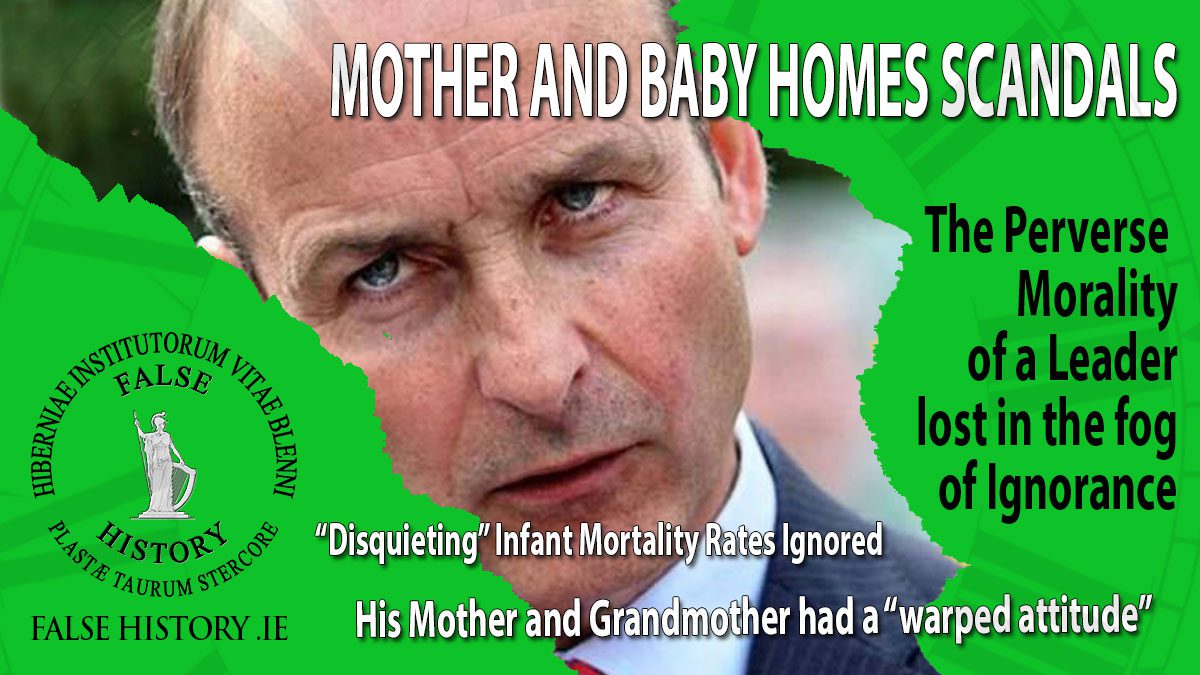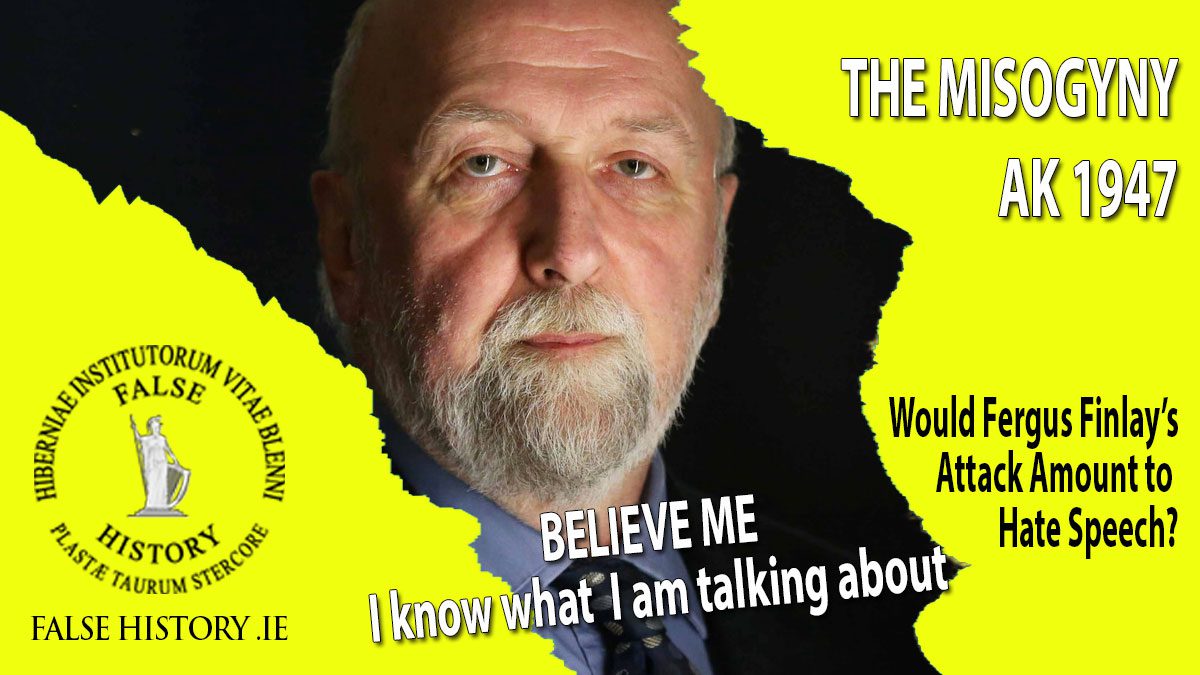During the second decade of the twenty-first century, under the rule of the Taoiseach/Prime minister Micheál Martin, children born to a cohort of mothers suffer from infant mortality rates that are multiples that of the average. High infant mortality rates present in a previous era of Irish history were referred to by the Taoiseach as ‘disquieting’, and he went on to attack the apparent lack of action on behalf of the authorities, labelling it ‘distressing’. Yet, the same statistics and apparent inaction are very much in evidence during his tenure as the nation’s leader. As we will see, it would be an example of gross hypocrisy if it was not for the presence of ignorance. The Taoiseach was given his opinion by the commission of investigation into mother and baby homes. It appears that the commission thought that they had sufficient expertise in the areas of vintage medicine, pathology and medical statistics that they did not need to consult with experts in such fields. Accordingly, the commission used assumptions in places where it could have used evidence and consequently arrived at wildly inaccurate conclusions. On top of these assumptions, the Taoiseach used his own assumptions and used them to accuse his mother and grandmother; he said they ‘embraced a perverse religious morality and control, judgementalism and moral certainty’. They ‘had a completely warped attitude to sexuality and intimacy, and young mothers’. There you have it; the entire Martin family were sneering at unmarried mothers and oppressed women and children. The Irish view their own history and society through cowhight tinted glasses, accordingly Micheál Martin was not able to see the contemptuousness he holds for his own family, because in Irish society, one can sneer at everyone else and not think that such sneers apply to oneself nor to one’s kin.
In societies where the intellectual tradition is not dead, there is a commitment to the scientific study of problems to improve the conditions for its citizens and humanity. In countries like the UK and Sweden, researchers continue to study high infant mortality rates and look for causes. Even today, the evidence shows that the infant mortality rates for children born to unmarried mothers are significantly higher than for children born to married parents. Ireland does not measure or at least does not publish such statistics, but if they were ever made public, they would likely show the same problem exists in Irish society.
The Taoiseach can quite happily rule over a nation where the infant mortality rate for traveller children is over three and a half times that of the average. It is likely that the English rates of 40% greater infant mortality for children of unmarried mothers also applies to Ireland, then our Taoiseach is gravely in error to attack the dead when he is in no position to grasp the significance of the statistics lying on his own desk.
 Erudite research, both scientific and social, continues to show that the causes of high infant mortality rates and high mortality rates, in general, are due to deprivation and poverty. The commission of investigation was unaware of this present-day research and so used the assumption that high infant mortality rates were due almost entirely to the spread of disease. They took no account of that the use of the word ‘congenital’ on deaths certificates which meant that a disease or a condition was present at birth. Consequently, they assumed that deaths were due to overcrowding and cots too close together. They might not have reached such conclusions if they visited the nursery in a modern maternity hospital and observed the current practices with cots close together. The commission also tells us that Tuam was never overcrowded, yet the home’s high infant mortality rates triggered the whole scandal.
Erudite research, both scientific and social, continues to show that the causes of high infant mortality rates and high mortality rates, in general, are due to deprivation and poverty. The commission of investigation was unaware of this present-day research and so used the assumption that high infant mortality rates were due almost entirely to the spread of disease. They took no account of that the use of the word ‘congenital’ on deaths certificates which meant that a disease or a condition was present at birth. Consequently, they assumed that deaths were due to overcrowding and cots too close together. They might not have reached such conclusions if they visited the nursery in a modern maternity hospital and observed the current practices with cots close together. The commission also tells us that Tuam was never overcrowded, yet the home’s high infant mortality rates triggered the whole scandal.
 No competent statistician would draw inferences from crude statistics like the Irish mother and baby homes commission has done. It has long been known that hospitals that deal with high-risk individuals have higher mortality rates. An example would be the recent media reports that several of Ireland’s biggest hospitals had high mortality rates for different conditions. In 2017, the National Audit of Hospital Mortality (NAHM) found a higher mortality rate was recorded at Cork University Hospital (CUH) for ischaemic stroke than anywhere else in the country. At first glance, it might appear that if you were suffering from a stroke, CUH is the last place you would want to be. It is natural to equate high mortality statistics with poor quality care, but such an inference cannot be made from basic statistics. All statisticians and data scientists are taught how to avoid the logical fallacy of ‘false causes’ from the very beginning. Essentially, in this case, it means that one cannot use high infant mortality rates to imply poor quality health care without looking for other causes.
No competent statistician would draw inferences from crude statistics like the Irish mother and baby homes commission has done. It has long been known that hospitals that deal with high-risk individuals have higher mortality rates. An example would be the recent media reports that several of Ireland’s biggest hospitals had high mortality rates for different conditions. In 2017, the National Audit of Hospital Mortality (NAHM) found a higher mortality rate was recorded at Cork University Hospital (CUH) for ischaemic stroke than anywhere else in the country. At first glance, it might appear that if you were suffering from a stroke, CUH is the last place you would want to be. It is natural to equate high mortality statistics with poor quality care, but such an inference cannot be made from basic statistics. All statisticians and data scientists are taught how to avoid the logical fallacy of ‘false causes’ from the very beginning. Essentially, in this case, it means that one cannot use high infant mortality rates to imply poor quality health care without looking for other causes.
CUH has a specialist stroke unit, and so patients are sent to it from other hospitals and directly from the community, avoiding other hospitals. Consequently, CUH has many more patients at risk of dying from a stroke than any other hospital. That is why it has a higher mortality rate, not because the patients received poor quality treatment. A hospice is a hospital with mortality rates of close to 100 per cent. Hospitals offering palliative care have high mortality statistics than those with none. What can be inferred from these ‘appalling mortality rates?
Crude statistics are so useless an indicator that statisticians have tried to effect improvements by factoring in differences in the population and their risk of death. These called standardised mortality ratios (SMR), and ones designed explicitly for hospitals, are Hospital Standardised Mortality Ratio (HSMR). The intention is to try and spot hospitals where the treatments could be improved.
In a scandal that bore many striking similarities to the Irish mother and baby homes scandal, high HSMRs were spotted at the UK’s Stafford Hospital, Staffordshire, in 2009. ‘The regulator condemned “appalling” standards of care and reported there had been at least 400 more deaths than expected between 2005 and 2008.’ Patients came out of the woodwork and claimed that they had been mistreated. An enquiry was set up, ‘it heard accounts of almost unimaginable neglect – with patients left in soiled sheets, others crying out in pain and some so dehydrated they drank from flower vases.’ The team went through more than one million pages of evidence. In his report, published in February 2013, Sir Robert found there were failings from the top to the bottom of the NHS, commenting, ‘this is a story of appalling and unnecessary suffering of hundreds of people. They were failed by a system which ignored the warning signs and put corporate self-interest and cost control ahead of patients and their safety.’[1]
The British prime minister issued an apology on behalf of the government.
The whole sordid affair has been the subject of debate within science ever since. It turns out that the scientists are sure that conditions at Stafford Hospital were no worse than at other hospitals and that the statistics were pretty useless. One team of researchers stated:
Using the HSMR [hospital standardised mortality ratios] to identify ‘good/bad’ hospitals is analogous to the practice of dowsing—the search for water without scientific apparatus—it is time to abandon this screening test and search for a better one.[2]
If the standardised statistics we use today are deficient, then the reliance on raw statistics of the past to imply causes is amateurishly inept.
The evidence is clear; the commission of investigation and many mother and baby home commentators have no expertise in statistics, medical statistics, epidemiology, nursing care or in vintage medicine. Yet they take it upon themselves to make pronouncements which no expert could make.
The leader of the Irish nation, Micheál Martin, has not got the time, expertise, or the wit to know anything about statistics. Like many others, he launched a scathing and scurrilous attack on his own people based on no more than an ignorant and inept interpretation of the evidence.
Michael Martin used the word ‘we’ to include my family and relations in his outburst. I say sneer at your own family before you sneer at others. See if they like it. Open your eyes to the high infant mortality rates under your own nose, and then accuse yourself of a ‘perverse morality’ and of being ‘distressingly’ indifferent to the plight of these children.
EJ
[1] https://www.bbc.com/news/uk-england-stoke-staffordshire-50836324
[2] Mohammed, M. A., R. Lilford, G. Rudge, R. Holder, and A. Stevens. ‘The Findings of the Mid-Staffordshire Inquiry Do Not Uphold the Use of Hospital Standardized Mortality Ratios as a Screening Test for ‘Bad’Hospitals’. QJM: An International Journal of Medicine 106, no. 9 (2013): 849–54.


